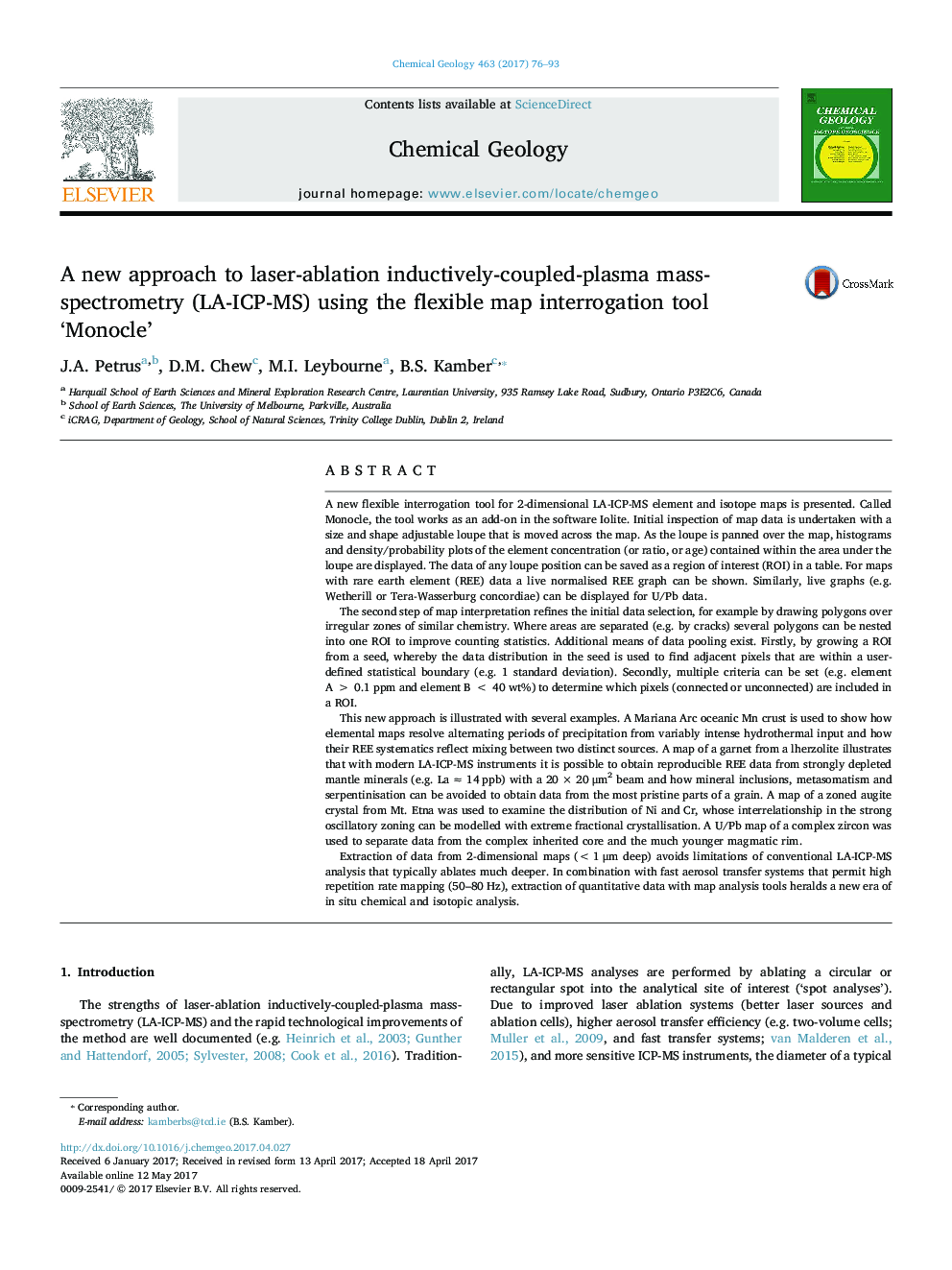| کد مقاله | کد نشریه | سال انتشار | مقاله انگلیسی | نسخه تمام متن |
|---|---|---|---|---|
| 5782616 | 1637511 | 2017 | 18 صفحه PDF | دانلود رایگان |

- A new software tool for LA-ICP-MS map data analysis is documented.
- Live inspectors (e.g. REE, U-Pb plots) update as the mouse is panned over a map.
- Regions of interest can be defined by a loupe, drawing, growing a seed, or criteria.
- Improved map 'feature' discoverability and data extraction thereof
- A powerful alternative to more traditional LA-ICP-MS spot analyses
A new flexible interrogation tool for 2-dimensional LA-ICP-MS element and isotope maps is presented. Called Monocle, the tool works as an add-on in the software Iolite. Initial inspection of map data is undertaken with a size and shape adjustable loupe that is moved across the map. As the loupe is panned over the map, histograms and density/probability plots of the element concentration (or ratio, or age) contained within the area under the loupe are displayed. The data of any loupe position can be saved as a region of interest (ROI) in a table. For maps with rare earth element (REE) data a live normalised REE graph can be shown. Similarly, live graphs (e.g. Wetherill or Tera-Wasserburg concordiae) can be displayed for U/Pb data.The second step of map interpretation refines the initial data selection, for example by drawing polygons over irregular zones of similar chemistry. Where areas are separated (e.g. by cracks) several polygons can be nested into one ROI to improve counting statistics. Additional means of data pooling exist. Firstly, by growing a ROI from a seed, whereby the data distribution in the seed is used to find adjacent pixels that are within a user-defined statistical boundary (e.g. 1 standard deviation). Secondly, multiple criteria can be set (e.g. element A > 0.1 ppm and element B < 40 wt%) to determine which pixels (connected or unconnected) are included in a ROI.This new approach is illustrated with several examples. A Mariana Arc oceanic Mn crust is used to show how elemental maps resolve alternating periods of precipitation from variably intense hydrothermal input and how their REE systematics reflect mixing between two distinct sources. A map of a garnet from a lherzolite illustrates that with modern LA-ICP-MS instruments it is possible to obtain reproducible REE data from strongly depleted mantle minerals (e.g. La â 14 ppb) with a 20 Ã 20 μm2 beam and how mineral inclusions, metasomatism and serpentinisation can be avoided to obtain data from the most pristine parts of a grain. A map of a zoned augite crystal from Mt. Etna was used to examine the distribution of Ni and Cr, whose interrelationship in the strong oscillatory zoning can be modelled with extreme fractional crystallisation. A U/Pb map of a complex zircon was used to separate data from the complex inherited core and the much younger magmatic rim.Extraction of data from 2-dimensional maps (< 1 μm deep) avoids limitations of conventional LA-ICP-MS analysis that typically ablates much deeper. In combination with fast aerosol transfer systems that permit high repetition rate mapping (50-80 Hz), extraction of quantitative data with map analysis tools heralds a new era of in situ chemical and isotopic analysis.
306
Journal: Chemical Geology - Volume 463, 5 July 2017, Pages 76-93